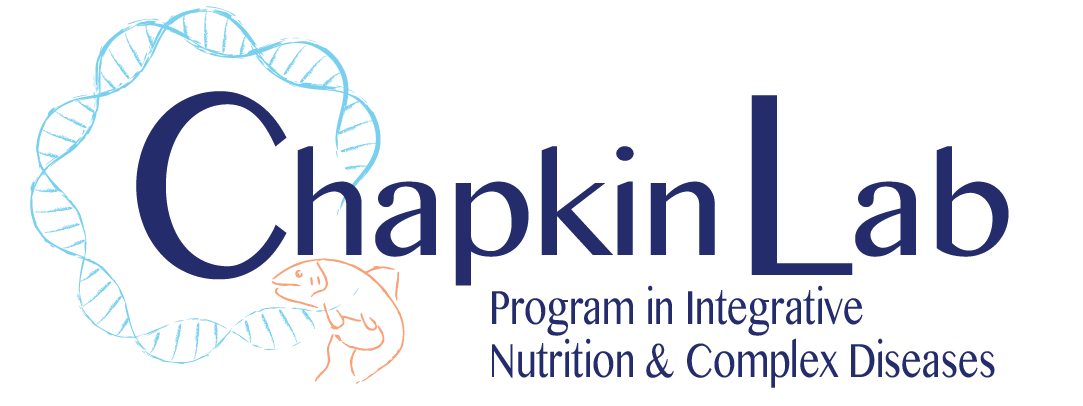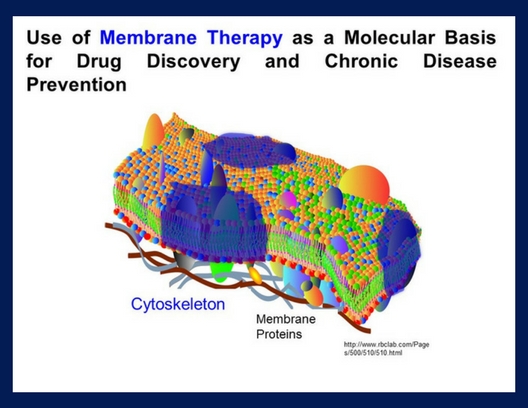USE OF MEMBRANE THERAPY AS A MOLECULAR BASIS FOR DRUG DISCOVERY AND CHRONIC DISEASE PREVENTION
Proteins are often credited as the macromolecule responsible for performing critical cellular functions, however lipids have recently garnered more attention as our understanding of their role in cell function and human health becomes more apparent. Although cellular membranes are the lipid environment in which many proteins function, it is now apparent that protein and lipid assemblies can be organized to form distinct micro- or nanodomains that facilitate signaling events. Indeed, it is now appreciated that cellular function is partly regulated by the specific spatiotemporal lipid composition of the membrane, down to the nanosecond and nanometer scale. Furthermore, membrane composition is altered during human disease processes such as cancer and obesity. For example, an increased rate of lipid/cholesterol synthesis in cancerous tissues has long been recognized as an important aspect of the rewired metabolism of transformed cells. However, the contribution of lipids/cholesterol to cellular function in disease models is not yet fully understood. Furthermore, an important consideration in regard to human health is that diet is a major modulator of cell membrane composition. This can occur directly through incorporation of membrane substrates, such as fatty acids, e.g., n-3 polyunsaturated fatty acids (n-3 PUFA) and cholesterol. Thus, in the Chapkin lab, we examine scenarios in which changes in membrane composition impact human health. Particular focus is placed on the importance of intrinsic lipid/cholesterol biosynthesis and metabolism and extrinsic dietary modification in cancer and its effect on plasma membrane properties.
- A. Erazo-Oliveras, M. Muñoz-Vega, M. Mlih, V. Thiriveedi, M.L. Salinas, J.M. Rivera-Rodriguez, E. Kim, R.C. Wright, X. Wang, K. Landrock, J. Roper, J. Karpac and R.S. Chapkin. Mutant APC reshapes plasma membrane nanodomains by altering cholesterol levels via oncogenic β-catenin signaling. Nature Communications 14:4342, 2023. PMID:37468468, PMCID: PMC10356786
- Osorio, Y. Zhong, G. Li, Q. Xu, A. Hillhouse, J. Chen, L.A. Davidson, Y. Tian, R.S. Chapkin, J.Z. Huang and J.J. Cai. scTenifoldKnk: An efficient virtual knockout tool for gene function predictions via single-cell gene regulatory network perturbation. doi.org/10.1016/j.patter.2022.100434. Patterns 3:100434, 2022.
- N.R. Fuentes, M.L. Salinas, X. Wang, Y.Y. Fan and R.S. Chapkin. Assessment of plasma membrane fatty acid composition and fluidity using imaging flow cytometry. Methods in Molecular Biology, Ras activity and signaling. Eds, I. Rubio and I. Prior, Springer Nature 2262:251-258, 2021. PMID: 33977481, PMCID: PMC8549482
- N.R. Fuentes, M. Mlih, X. Wang, G. Webster, S. Cortes-Acosta, I.R. Corbin, J. Karpac and R.S. Chapkin. Membrane therapy using docosahexaenoic acid suppresses EGFR signaling by disrupting cholesterol-dependent nanocluster formation. Journal of Lipid Research 62: 100026, 2021. PMID:33515553, PMCID: PMC7933808
- Levental, KR, Malmberg, E, Symons, JL, Fan, YY, R.S. Chapkin, Ernst, R et al.. Lipidomic and biophysical homeostasis of mammalian membranes counteracts dietary lipid perturbations to maintain cellular fitness. Nat Commun. 2020;11 (1):1339. doi: 10.1038/s41467-020-15203-1. PubMed PMID:32165635 .
- Salinas, ML, Fuentes, NR, Choate, R, Wright, RC, McMurray, DN, R.S. Chapkin et al.. AdipoRon Attenuates Wnt Signaling by Reducing Cholesterol-Dependent Plasma Membrane Rigidity. Biophys. J. 2020;118 (4):885-897. doi: 10.1016/j.bpj.2019.09.009. PubMed PMID:31630812 PubMed Central PMC7036725.
- Torres-Adorno AM, Vitrac H, Qi Y, Tan L, Levental KR, Fan YY, Yang P, R.S. Chapkin, Eckhardt BL, Ueno NT. Eicosapentaenoic acid in combination with EPHA2 inhibition shows efficacy in preclinical models of triple-negative breast cancer by disrupting cellular cholesterol efflux. Oncogene. 2018 Nov 20. doi:10.1038/s41388-018-0569-5. [Epub ahead of print] PubMed PMID: 30459358.
- Erazo-Oliveras A, Fuentes NR, Wright RC, R.S. Chapkin. Functional link between plasma membrane spatiotemporal dynamics, cancer biology, and dietary membrane-altering agents. Cancer Metastasis Rev. 2018 Sep;37(2-3):519-544. doi: 10.1007/s10555-018-9733-1. PubMed PMID: 29860560.
- R. Fuentes, M. Mlih, R. Barhoumi, P. Hardin, T. Steele, S. Behmer, I. Prior, J. Karpac and R.S. Chapkin. Long chain n-3 fatty acids attenuate oncogenic Ras-driven proliferation by altering plasma membrane nanoscale proteolipid composition. Cancer Research. 2018 Jul 15;78(14):3899-3912. PMID: 29769200 PMCID: PMC6050089 doi: 10.1158/0008-5472.CAN-18-0324. Epub 2018 May 16..
- R. Fuentes, E. Kim, Y.Y. Fan, and R.S. Chapkin. Omega-3 fatty acids, membrane remodeling and cancer prevention. Molecular Aspects of Medicine. PMID:29627343, PMCID:PMC6185832
- Y. Fan, N.R. Fuentes, T.Y. Hou, R. Barhoumi, X.C. Li, N.E. Deutz, M.P. Engelen, D.N. McMurray and R.S. Chapkin. Remodeling of primary human CD4+ T cell plasma membrane order by n-3 polyunsaturated fatty acids. British Journal of Nutrition, 119:163-175, 2018. PMID:29249211
- R. Fuentes, M.L. Salinas, E. Kim and R.S. Chapkin. Emerging role of chemoprotective agents in the dynamic shaping of plasma membrane organization. Biochimica et Biophysica Acta-Biomembranes 1859:1668-1678, 2017. PMID:28342710, PMCID:PMC5501766
- Y. Fan, E. Callaway, J.M. Monk, P. Yang, L. Vincent and R.S. Chapkin. A new model to study the role of arachidonic acid in colon cancer pathophysiology. Cancer Prevention Research 9:1-8, 2016. PMID:27339171 PMC5010973
- Y. Hou, R. Barhoumi, Y.Y. Fan, G.M. Rivera, R.N. Hannoush, D.N. McMurray and R.S. Chapkin. n-3 polyunsaturated fatty acids uniquely alter phosphatidylinositol-(4,5)-bisphosphate (PIP2) organization which precedes suppression of the CD4+ T cell proliferative response. Biochimica et Biophysica – Biomembranes 1858:85-96, 2015. PMID:26476105 PMC4663135
- H.F. Turk, J.M. Monk, Y.Y. Fan, E.S. Callaway, B. Weeks and R.S. Chapkin. Inhibitory effects of omega-3 fatty acids on injury induced epidermal growth factor transactivation contribute to delayed wound healing. American Journal of Physiology 304:C905-C917, 2013. PMID:23426968 PMC3651607
- Y. Fan, J. Monk, T. Hou, E. Callaway, L. Vincent, B. Weeks, P. Yang and R.S. Chapkin. Characterization of an arachidonic acid-deficient (FADS1 knock-out) mouse model. Journal of Lipid Research 53:1287-1295, 2012. PMID:22534642 PMC3371240
- H.F. Turk, R. Barhoumi and R.S. Chapkin. Alteration of EGFR spatiotemporal dynamics suppresses signal transduction. PLoS One 7(6):e39682, June, 2012. PMID: 22761867 PMCID: PMC3384615
- W. Kim, Y.Y. Fan, R. Barhoumi, R. Smith, D.N. McMurray and R.S. Chapkin. n-3 polyunsaturated fatty acids suppress the localization and activation of signaling proteins at the immunological synapse in murine CD4+ cells by affecting membrane raft formation. Journal of Immunology 181:6236-6243, 2008. PMID: 18941214 PMCID: PMC2597670
- R.S. Chapkin, N. Wang, Y.Y. Fan, J.R. Lupton and I.A. Prior. Docosahexaenoic acid alters the size and distribution of cell surface microdomains. Biochimica et Biophysica Acta – Biomembranes 1778:466-471, 2008. PMID: 18068112 PMCID: PMC2244794
- J. Seo, R. Barhoumi, A.E. Johnson, J.R. Lupton and R.S. Chapkin. Docosahexaenoic acid selectively inhibits plasma membrane targeting of lipidated proteins. FASEB Journal 20:770-772, 2006. PMID: 16469846
- Y.Y. Fan, L.H. Ly, R. Barhoumi, D.N. McMurray and R.S. Chapkin. Dietary docosahexaenoic acid suppresses T-cell protein kinase C-theta lipid raft recruitment and interleukin-2 production. Journal of Immunology 173:6151-6160, 2004. PMID: 15528352
- W.L. Ma, J. Seo, L.A. Davidson, E.S. Callaway, Y.Y. Fan, J.R. Lupton and R.S. Chapkin. n-3 PUFA alter caveolae lipid composition and resident protein localization in mouse colon. Faseb Journal, April 15, 2004. 10.1096/fj.o3-0604fje, 18:1040-1042, 2004.

